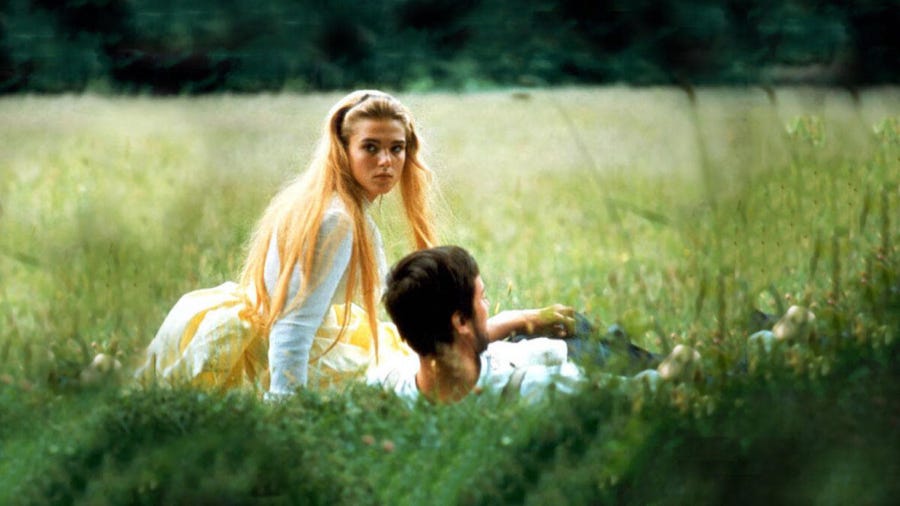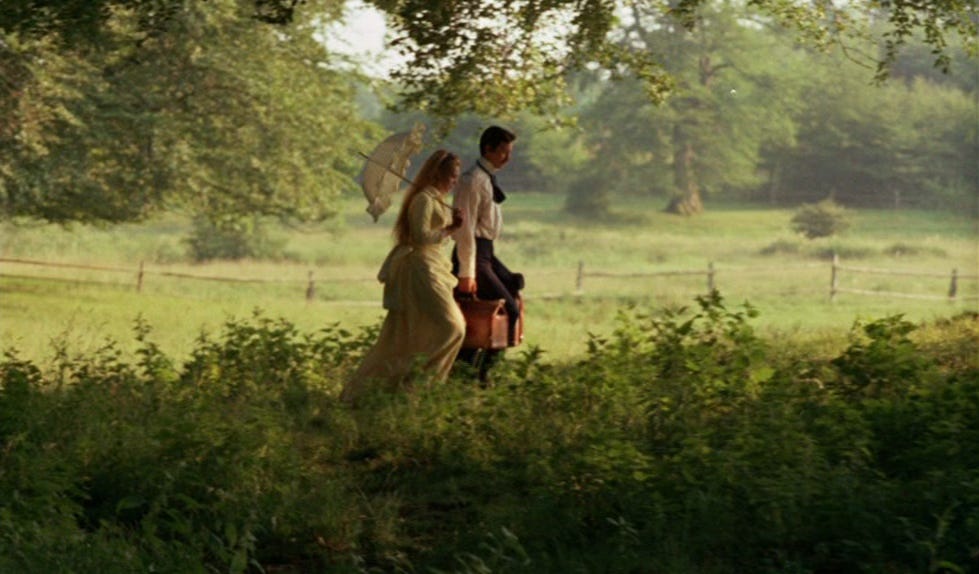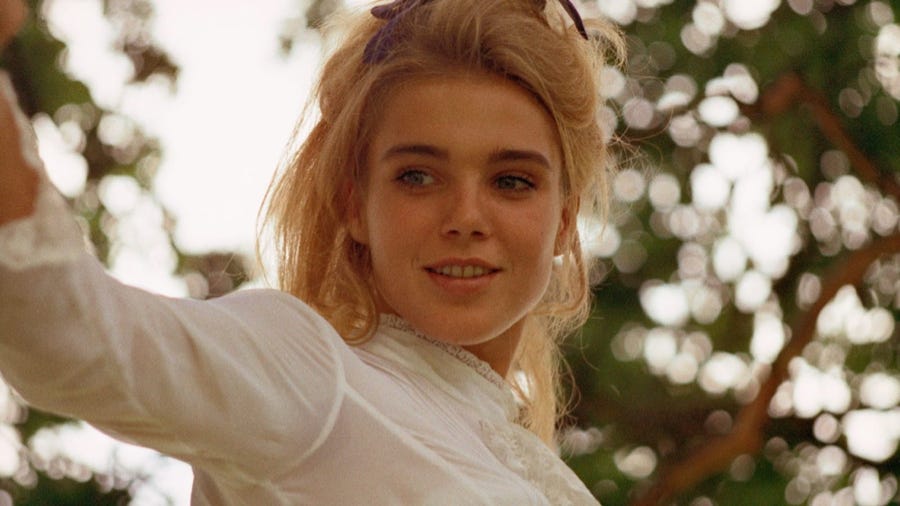And so we come to Elvira Madigan (1967), the second film in this weekend’s mini-series. At the time of release, Elvira Madigan became a Swedish art-house sensation, with a host of award nominations and female lead, Pia Degermark, winning ‘Best Actress’ at the 1967 Cannes Film Festival. The use of popular (if anachronistic) 17th and 18th-century classical music, especially Mozart’s 21st Piano Concerto (performed by Géza Anda), led to various film tie-ins, with Deutsche Grammophon releasing a Mozart LP featuring stills from the film.
Elvira is very much an aesthete’s picture (i.e. visually and audibly beautiful), ‘the most beautiful film ever made’, and to that distinguished list, I think, we must add Kubrick’s Barry Lyndon (1975), Luchino Visconti’s Death in Venice (1970), Picnic at Hanging Rock (1975), The Duellists (1977) and The French Lieutenant’s Woman (1981). This aesthete concept: I don’t think there’s anything wrong with that. God knows we live in a coarse, hideous world with ugliness all around us. Visuals are important. As is sound. And, in any event, as with Truffaut’s The Story of Adele H. (1975), Elvira Madigan is based on a tragic, true story — a sad affair which became a press sensation. In the summer of 1889, Hedvig Jensen, a Danish tightrope dancer, juggler and artistic rider (stage name, Elvira Madigan), ran away with a married father of two children, Swedish aristocrat and Officer of Dragoons, one Lieutenant Count (Sixten) Sparre (Thommy Berggren). I’m not going to ruin the plot for you, but what I can say is that the sad affair reminds me of Manon Lescaut, or, certainly the Mayerling tragedy of 1889. And director, Bo Widerberg, shot the film in an improvised, Impressionist style, en plein air, a homage to Renoir, with a hand-held camera and diffused, natural light. There’s rustling leaves and reeds. There’s a sense of place. The story has been filmed three times, the first in 1943, with two later versions, both filmed in 1967, including, apart from Elvira Madigan, a Danish interpretation directed by Poul Erik Møller Pedersen.
By the late 60s, in contrast to the saturated — and static — studio pictures of the 50s and early 60s, improvements in film technology allowed for backlighting, lens flare and soft-focus — a play on natural light, then seen as a more realistic approach. Elvira either caught or created the zeitgeist, or perhaps, even, a bit of both: Laura Ashley and organic meadows;a hot, French August. As late as 1985, a series of British television commercials for Cadbury’s Phallic Flake featured pretty girls in fields of soft-focus sunflowers and poppies, the latter a straight lift from Claude Monet’s The Poppy Field near Argenteuil (1873). No coincidence, I think, that the Impressionist and Post-Impressionist market was then at its height (even, perhaps, more fashionable then than now), fuelled by Japanese tycoons and their art ‘investments’ squirrelled away in secretive underground vaults. In 1987, at Sotheby’s New York, Van Gogh’s Irises fetched $53.9 million. And there’s a scene (in Elvira) where Hedvig trades in her Toulouse Lautrec, drawn in a Parisian café, for a pittance.
Some have accused Elvira of style over substance; an accusation, I think, slightly unfair, or, perhaps even missing the point. There’s more to the film. The ending is genuinely shocking and bleak — even nihilistic. Romantic love is all fine and dandy, but it ain’t enough. It can’t survive alone. And that’s the point. The penniless and a hungry couple, on the run (Lieutenant Sparre facing a court martial for desertion) are forced to roam the Danish countryside, staying at inns, hotels and guest houses; to survive by petty theft and Sparre’s winnings at the gaming table. I now see why the film was compared to Bonnie and Clyde, which came out in the same year.
Pia Degermark, of course, is desperately pretty, in that late Sixties way — with scraped back hair, black mascara and Alice band, and again, even if the characters dine formally al fresco, overlooking a lake, and drink Crème de menthe, the languid picnic scenes have a druggy, drowsy, drop-out hippy vibe, much appreciated at the time and, actually, quite similar in a way to Peter Weir’s Picnic at Hanging Rock (1975). Roger Ebert gave Elvira 4/4 stars and wrote, “Elvira Madigan is indeed remarkably beautiful, Almost every frame would make a painting, and yet the film is alive and cinematic, not simply photographs of pretty pictures.”
And I’m glad that he wrote that. For I like Elvira Madigan very much indeed. It’s one of my favourite films, and holds up well over repeat viewings. A worthy addition to the WEEKEND FLICKS. stable. I watched Elvira via YouTube, where some kind person has posted the complete film, viewable in a decent quality recording, with English subtitles. It’s also available on DVD and Blu-ray. The Deutsche Grammophon LP, featuring Mozart’s 21st Piano Concerto, as played in the film, is also worth looking out for
Okay. That was film no. 126 and as it’s a Sunday, free to read by everybody and anybody. Friday’s posts, on the other hand, are for the paid subscribers — although I try to include a generous paragraph or two at the beginning, for free. Become a ‘paid’ subscriber (£5 a month or £50 a year) and you’ll get the full post on a Friday morning, plus further ‘bonus’ posts on High Days and Holy Days — and access to the entire WEEKEND FLICKS. archive which now includes 126 film recommendations. Worth thinking about. But either option’s a good bet.
I’ll be back on Friday. In the meantime I hope you enjoy Elvira Madigan (1967) as much as I did. It’s a perfect drowsy, languid Sunday afternoon flick. Crème de Menthe for this one.
.










All of the films on the list were made within 15 years of each other, they're all in color, they're all period pieces, and they're all set in 18th through late 19th century Europe (or, in the case of PICNIC AT HANGING ROCK, turn of the 20th century transplanted European culture in Australia). They're all "visually beautiful," but the beauty of ELVIRA MADIGAN is a universe away from the beauty of BARRY LYNDON--decorative underpinning vs. ironic counterpoint.
I've seen plenty of mediocre and even bad movies that are visually beautiful, shot by great DPs working with impeccable Production and Costume Designers and Location Managers. But in the end, that's pretty much all they are. I think that with BARRY LYNDON or PICNIC AT HANGING ROCK or, for instance, DAYS OF HEAVEN or PAT GARRETT AND BILLY THE KID or RAGING BULL or MIRROR or RAN, to stay more or less in the window of time in the list, the particular sense of beauty does something, activates something, within the action. It plays an active role. In Bergman's films too, and in THE LEOPARD, mentioned above.
Can I ask: how about black and white? How about pre-1967 and post-1981 cinema from around the world? Movies shot by James Wong Howe or Gregg Toland or Kazuo Miyagawa or Michael Ballhaus? Movies by Sternberg or Ford or Hitchcock or Minnelli?
Oh gosh! What a film! I saw it, Un Homme et une Femme and Bonnie & Clyde soo many times! They were all good girl friend bate! They were all very romantic and picturesque. The other one is the Gattopardo - a feast for the eyes!